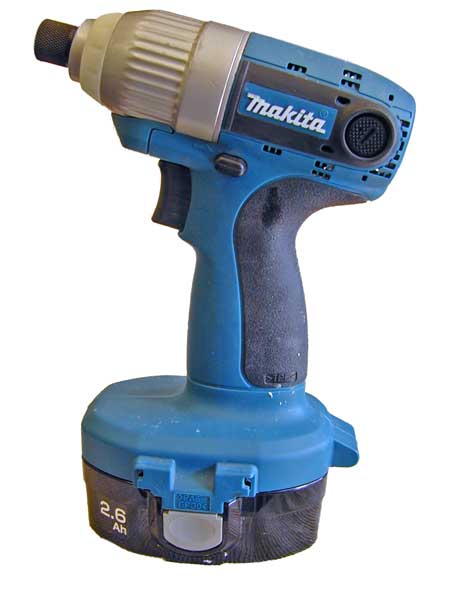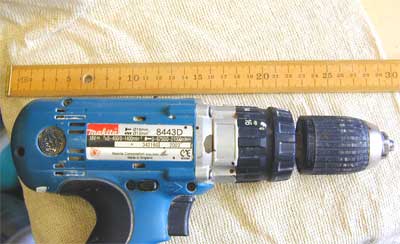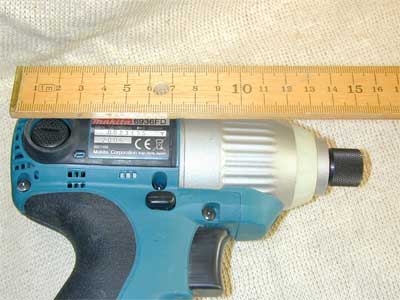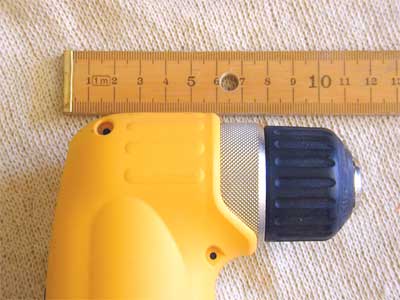Difference between revisions of "Impact driver"
m (→The good) |
|||
| (2 intermediate revisions by the same user not shown) | |||
| Line 59: | Line 59: | ||
They are not so good at small screws that require low torque – partly because their rotation speed is typically much higher than a drill driver with a low speed setting on its gear box (the drill driver would typically have a variable speed in the 0 – 600 or possibly even 0 – 300 rpm range. Impact drivers are usually geared more highly when in rotation only mode – typically in the 0 – 3000+ rpm range). Hence even delicate use of the trigger speed controller results in less accurate speed and torque delivery. | They are not so good at small screws that require low torque – partly because their rotation speed is typically much higher than a drill driver with a low speed setting on its gear box (the drill driver would typically have a variable speed in the 0 – 600 or possibly even 0 – 300 rpm range. Impact drivers are usually geared more highly when in rotation only mode – typically in the 0 – 3000+ rpm range). Hence even delicate use of the trigger speed controller results in less accurate speed and torque delivery. | ||
| − | + | Impact drivers are loud! When operating in impact mode they not only emit significant noise locally (sounding like a demented woodpecker), they also send far more shock noise through the fabric of the building. This may be of particular importance when using them in inhabited workspaces, or homes. Note that there are some newer oil filled hydraulic action impact drivers becoming available which are claimed to be less noisy. | |
Bit wear rates can be high – especially if not applying sufficient pressure to the driver to keep it well seated on the fastening. Allowing the bit to “rattle” in the screw head can result in useless screwdriver bit in the space of one longish screw! Even high quality diamond impregnated bits are not immune. | Bit wear rates can be high – especially if not applying sufficient pressure to the driver to keep it well seated on the fastening. Allowing the bit to “rattle” in the screw head can result in useless screwdriver bit in the space of one longish screw! Even high quality diamond impregnated bits are not immune. | ||
| Line 73: | Line 73: | ||
=What jobs are they good for?= | =What jobs are they good for?= | ||
| − | Driving large and medium sized screws (typically | + | Driving large and medium sized screws (typically 6 gauge screws and up), without the need for a pilot hole in many cases. Turning big screws, or screws into stiff wall plugs, or through metal studding, Sticking coach screws in joists, and decking. Freeing seized screws and bolts. |
=Any jobs they are usable for, but offer no special advantage?= | =Any jobs they are usable for, but offer no special advantage?= | ||
| Line 102: | Line 102: | ||
=Second hand tools= | =Second hand tools= | ||
| − | + | If buying a used tool allow for the possibility that the batteries may be nearing replacement time. Check that the charger is supplied. | |
| − | |||
=See also= | =See also= | ||
Revision as of 00:57, 3 April 2018
Impact Driver
Disambiguation
There are a variety of different tools that get given the title “impact driver”. The original use of the term applied to a sturdy, hand held, metal barrel shaped device, that was designed to loosen (or tighten) stubborn screws, this it achieves by being clobbered with a hammer – each blow turning the bit holder a small fraction of a rotation.
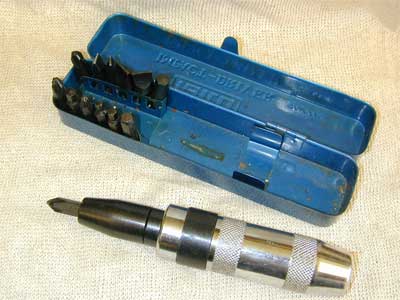 |
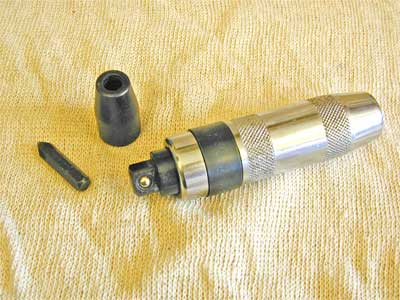
|
Still a favourite in mechanics workshops, but not what we are discussing here.
The term is also applies to a range of powered rotary tools that feature an angular percussive action designed to increase the torque applied to a fixing by applying high levels of it in discrete blows, rather than as a continuously applied force. The term covers both electric and pneumatic tools, with a range of bit coupling interfaces. The larger units (also often called impact wrenches), typically have a square drive output shaft designed to connect directly to conventional hex sockets (you most commonly see these used on service forecourts for removing wheel nuts on cars). The smaller tools typically have a hex drive designed to take ordinary screwdriver bits or the type used with cordless drills and screwdrivers.
For the purposes of this document we are discussing the smaller cordless electric screw driving tools only:
What does it do?
Drives threaded fastenings basically. In use it initially behaves rather like a powered screwdriver, however as the resistance to the screw turning increases, the driver will automatically switch to its impact mode. This continues to drive the screw (far slower than initially) but with much greater torque.
The good
These drivers very good at coping with screw driving tasks like the penetration of metal panels or studwork using self tapping (or self drilling and tapping) screws where you often encounter a point where the screw requires a massive increase in torque to start cutting the thread.
They are good for moving heavy coach screws (aka lag screws) that usually require a spanner or socket set to drive fully home. Also for a wide range of wood screws including long or large screw, or screws driven into hard materials without pilot holes.
The nature of the drive also tends to reduce “cam out” (i.e. the tendency of the bit to slip in the head of the screw, causing damage to both the head and the bit and making further driving more difficult). As a result you can often drive screws while needing less pressure applied to the driver to keep the bit engaged in the screwhead, and this in turn means less operator fatigue. When in impact mode, very little of the torque developed at the bit is transmitted back to the operator, which again can lower the effort required to drive the fastening.
Many impact drivers are lighter and smaller than many comparable cordless drill drivers and combi drills:
| Combi drills are quite long |
| Impact drivers are typically half the length |
| Although still not as compact as an angle drill |
The short size and low weight makes driving fasteners in awkward positions (over head, at arms reach, up ladders etc) is easier.
The maximum torque obtainable is also significantly higher than with an equivalent voltage drill.
The bad
Even the best impact drivers lack the finesse of a drill/driver. They usually have no torque limiter, and hence rely on the operator to set the screw at the desired depth. If you are not paying attention they will happily drive a screw right through many materials to the point where it strips all the thread cut so far, snaps the screw, or makes a hole the size of the screws head right through the material!
They are not so good at small screws that require low torque – partly because their rotation speed is typically much higher than a drill driver with a low speed setting on its gear box (the drill driver would typically have a variable speed in the 0 – 600 or possibly even 0 – 300 rpm range. Impact drivers are usually geared more highly when in rotation only mode – typically in the 0 – 3000+ rpm range). Hence even delicate use of the trigger speed controller results in less accurate speed and torque delivery.
Impact drivers are loud! When operating in impact mode they not only emit significant noise locally (sounding like a demented woodpecker), they also send far more shock noise through the fabric of the building. This may be of particular importance when using them in inhabited workspaces, or homes. Note that there are some newer oil filled hydraulic action impact drivers becoming available which are claimed to be less noisy.
Bit wear rates can be high – especially if not applying sufficient pressure to the driver to keep it well seated on the fastening. Allowing the bit to “rattle” in the screw head can result in useless screwdriver bit in the space of one longish screw! Even high quality diamond impregnated bits are not immune.
Finally there are some (relatively rare) situations where in spite of their significantly higher torque, they will be unable to move a fixing that a conventional drill driver will move. This only happens when the fixing you are trying to turn is quite elastic and able to absorb the full moment of the rotational impact, without the end already driven into the wood turning. Moving this type of stuck fixing requires continuous torque to "wind up" the fixing and absorb the backlash.
Is a impact driver a suitable replacement to a drill driver or combi drill?
For the majority of users, no. However they are the ideal complement to a more conventional drill (and having both tools means not swapping bits so often when drilling pilot holes for screws). Not having a chuck makes holding drill bits more difficult (although you can get add on chucks designed for hex bit mounts, and there are also a limited range of drill bits available with hex mounts), and the impact mode of driving is not well suited to all drilling operations (tending to screw the larger bits into the work, rather than have it cut a nice round hole and clear the swarf in the process). They can work well for some drilling operations which either require very high torque and don’t require rapid bit rotation to clear swarf – e.g. driving auger bits, or an expansive bit, or for low torque operations on smaller bits where the impact mode of operation will not need to come into effect, and the high rotation speed can be used to advantage.
A significant cost saving can also be had by purchasing the driver "body only" (i.e. not including a charger or batteries) from the same maker, and in the same voltage as your main drill driver or combi drill. This will allow dual use of these potentially expensive items (for example, a 18V Makita kit containing three batteries plus charger and a carry case can easily cost £230+, whereas the same driver bought body only can typically be had for £70 - £80
What jobs are they good for?
Driving large and medium sized screws (typically 6 gauge screws and up), without the need for a pilot hole in many cases. Turning big screws, or screws into stiff wall plugs, or through metal studding, Sticking coach screws in joists, and decking. Freeing seized screws and bolts.
Any jobs they are usable for, but offer no special advantage?
Armed with the correct shrouded bit they can drive dry lining screws for fixing plasterboard etc, but they usually[1] do this no better than an ordinary drill and certainly less well than a dedicated autofeed dry lining driver, and depending on the screw length, may end up making lots of noise into the process. Without a shrouded bit to pop the driver off the screw head at the right depth, they are a liability.
[1] fixing plasterboard to the metal studs as is often used for shop fitting etc can be significantly easier with an impact driver.
Jobs they are poor at
Generally those needing very delicate control, especially driving small and or light screws and bolts. Note however that a new breed of lighter smaller impact drivers (like the Makita TD020DSE) change this somewhat since they are phsically very small and light, and hence much better suited to these tasks.
Although they can be used for some drilling operations they don't have the flexibility for use as an all round drilling tool, and are not suited to running many of the attachments that might typically be used to augment the capabilities of a drill (sanding, mixing paddles, and wire brush attachments etc).
Features
Not much choice here – most have a single speed gearbox with reversing action. Some have a small LED light to illuminate the head of the tool, A belt hook can be useful.
There are also a small number of four function combi drills becoming available. These are normal combi drills that also feature an impact driver capability.
Quality indicators
As with any cordless tool, the quality of the batteries and charger dictates to a large extent the overall performance of it. The best being streets ahead of the ordinary. Good speed control is vital in this type of tool since it is the only form of torque limiter you get (it controls the number of impacts per min in impact mode). Pro tools will have motors rated for continuous operation as well (the bulk of the tools currently available typically from the brands and makes oriented toward the professional user end of the market). Also be prepared to buy top quality screw driving bits.
Safety
Ear protection may be needed in some cases or with prolonged use. Eye protection is also advisable since the chance of shattering a bit or a fixing is greater.
Second hand tools
If buying a used tool allow for the possibility that the batteries may be nearing replacement time. Check that the charger is supplied.
